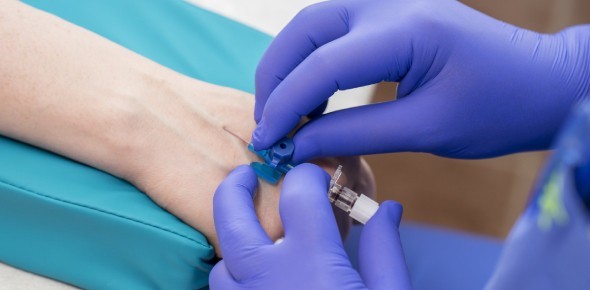A nurse is caring for a client who is hemorrhaging and hypotensive from esophageal variceal bleeding. Which of the following actions should the nurse take first?
Administer vasopressin to the client.
Request blood from blood bank.
Verify that the client has adequate IV access.
Insert an indwelling urinary catheter.
The Correct Answer is C
Verify that the client has adequate IV access.

Choice A rationale:
Administering vasopressin to the client might be necessary to manage the hemorrhage, but before any medication administration, it is crucial to ensure the client has adequate IV access. Vasopressin is a vasoconstrictor and can help control bleeding from esophageal varices, but its effectiveness relies on IV access to deliver the medication promptly.
Choice B rationale:
Requesting blood from the blood bank is essential for a client experiencing significant bleeding. However, the priority action is to verify IV access to administer any necessary blood products.
Choice C rationale:
This is the correct choice. Before initiating any interventions, ensuring the client has appropriate IV access is a priority. Adequate IV access is necessary to administer fluids, medications, or blood products promptly and effectively stabilize the client's blood pressure.
Choice D rationale:
Inserting an indwelling urinary catheter is not the priority action in this situation. While monitoring urine output is important, it should be secondary to addressing the client's hypotension and hemorrhage.
Nursing Test Bank
Naxlex Comprehensive Predictor Exams
Related Questions
Correct Answer is D
Explanation
Choice A rationale:
The nurse should not instruct the older adult client with osteoporosis to increase high-impact activities. Osteoporosis is a condition characterized by decreased bone density and strength, making high-impact activities potentially harmful as they could increase the risk of fractures.
Choice B rationale:
The nurse should not advise the client to consume a low-protein diet. Adequate protein intake is essential for maintaining muscle mass and overall musculoskeletal health, especially in older adults who may be at risk of muscle wasting.
Choice C rationale:
The nurse should not encourage the client to maintain a BMI of 30 to 35. A BMI within this range is considered obese and can put additional stress on the musculoskeletal system, increasing the risk of joint problems and other health issues.
Choice D rationale:
Including fiber in the diet is a correct instruction for promoting musculoskeletal health. Fiber-rich foods can help maintain bowel regularity and prevent constipation, which is important for overall comfort and mobility in older adults with osteoporosis.
Correct Answer is C
Explanation
Choice A rationale:
Notifying the surgeon of the temperature elevation is important, but it is not the nurse's priority. A temperature elevation after abdominal surgery could be a sign of infection, but the immediate action should be to assess the surgical incision for any signs of infection.
Choice B rationale:
Encouraging the client to drink more fluids is a good practice to maintain hydration and promote recovery after surgery. However, it is not the nurse's priority in this situation. The elevated temperature and potential infection take precedence over increasing fluid intake.
Choice C rationale:
This is the correct answer because the nurse's priority is to assess the surgical incision for signs of infection. An elevated temperature is a significant finding after surgery, and it may indicate a surgical site infection, which requires prompt assessment and intervention.
Choice D rationale:
Monitoring vital signs every 4 hours is an essential nursing intervention after surgery, but it is not the priority when the client has an elevated temperature and a recent surgical incision.
The nurse must first assess for signs of infection before proceeding with routine vital sign monitoring.
Whether you are a student looking to ace your exams or a practicing nurse seeking to enhance your expertise , our nursing education contents will empower you with the confidence and competence to make a difference in the lives of patients and become a respected leader in the healthcare field.
Visit Naxlex, invest in your future and unlock endless possibilities with our unparalleled nursing education contents today
Report Wrong Answer on the Current Question
Do you disagree with the answer? If yes, what is your expected answer? Explain.
Kindly be descriptive with the issue you are facing.
